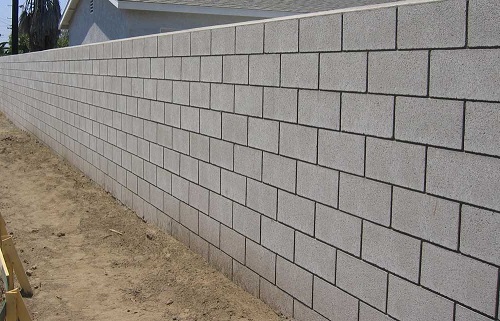In order to choose the best cinder block sealer, or cinder block paint, you need to understand how sealers and paint function, and how cinder block works as well.
Sealing an Exterior Cinder Block Wall
Sealing exterior cinder block is fairly straight forward. The most common type of sealer to use on exterior cinder block is a water repellent sealer. Water repellent sealers penetrate into the cinder block and the grout where they chemically react to form a hydrophobic barrier within the pores that causes water and other liquids to bead off the surface. Cinder block sealed with a water repellent sealer is more resistant to damage and deterioration caused by water absorption including cracking, spalling, pitting, freeze-thaw and salt damage, mold and mildew growth, and efflorescence.
The most common type of water repellent sealer for cinder block is a Silane-Siloxane hybrid sealer. Siliconate water repellent sealers can be used, but when applied to dark or porous surfaces will leave behind a visible white residue. Silane-Siloxane sealers won’t change the look or color of the cinderblock and they won’t leave behind a surface residue.
Best Water Repellent Sealers:
- Armor SX5000 Concrete Sealer Review (average 4.8 star review)
- Siloxane PD Concrete Sealer Review (average 4.5 star review)
- DryWay Water Repellent Concrete Sealer Review (average 3.8 star review)
What about silicate sealers? Silicate sealers, also known as densifiers, chemically react to form a crystalline barrier within the pores. Silicates are used to increase the strength and density in order to reduce dusting and deterioration caused by a weak surface or surface abrasion. It never hurts to apply a silicate sealer, but silicate sealers won’t help against deterioration caused by water absorption, and water absorption is the leading cause of deterioration on a block wall. If a silicate sealer is used, a silane-siloxane water repellent sealer should also be applied 5-7 days after the application of the silicate.
Sealing Basement Cinder Blocks
First, if your cinder block has issues with water and moisture you need to understand that sealers and paint won’t be able to stop the flow of water or moisture through the block. You can reduce the flow, but when you block one entry point, another will open up. Here is how water moves through block:
- Water enters into the cinder block from the exterior. In some cases the water enters in through the top of the block (rain storms and melting snow and ice). In other cases the water enters in through the middle to bottom of the wall (water tables).
- Once the water enters into the block, it travels through the block. Some of the water comes through the block, some of it comes through the grout, and some of it travels to the bottom of the wall where it accumulates inside the block until enough pressure pushes it through the cinder block into the basement.
The most effective way to stop water from entering in through a cinderblock basement wall is to waterproof from the exterior. Direct water away from the house using exterior drainage systems and gutters. Seal the exposed block on the exterior with a Silane-Siloxane water repellent sealer or a paint. If you can stop water intrusion at the source, you will stop issues with water entering into the basement.
If you have minor issues with weeping or damp spots and aren’t finishing your basement, there are some sealers that can be used:
- Sodium Silicate: Fills in the pores with a crystalline barrier that slows down the movement of water. Typically requires 1-3 coats. Best Silicate Sealers.
- Silane-Siloxane Water Repellent: Fills in the pores with a hydrophobic barrier that slows down the movement of moisture. Typically requires 1-3 coats. Best Water Repellent Sealers.
Many people will use one of the above, or a combination of the two (apply a silicate first and a water repellent a week later). Another option is paint. You won’t see many manufacturers pushing paint because paint isn’t breathable and overtime, once moisture and water builds up behind the wall, the paint will start to chip and peel. Removing paint from cinder block is a very time consuming and expensive process (unless you can grind the entire surface off). If you are using paint, make sure you research all the pro’s and con’s first.

